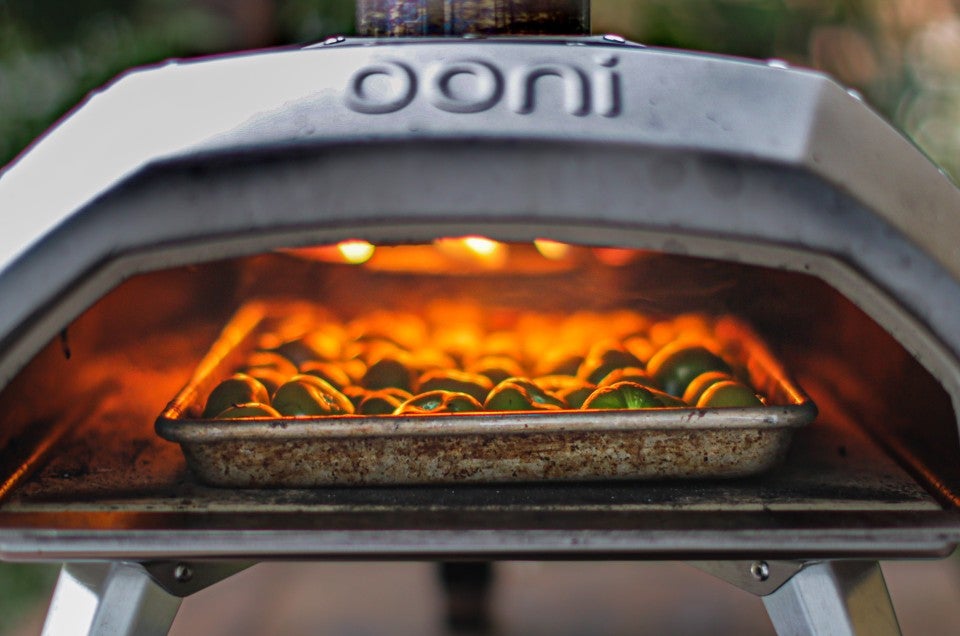


Pizza is not a special-occasion food — it’s an every occasion food. To help you embrace it, we've put together a four-point plan for designing the perfect pizza night, the one you can repeat week after week after week. This is Pizza Night, Perfected.
* * *
We needed more living space. Like so many others, the pandemic had my wife and I coexisting with three teenagers in a 1,000-square-foot house. Day in. Day out. You understand how things start to feel small.
So over a long weekend I built deck furniture: stools, a couch, a table, and a high top, following plans I found on YouTube. Lest you think I’m handy, I’m not. I made it all from cheap pine with a circular saw, a carpenter’s square, a drill, and a baker’s affinity for straight lines. Stained and sealed it looks decent (from a distance). With the addition of a sun shade and solar lights it transformed our little deck. Then I added the Ooni.
Having that deck — and most importantly, the tabletop wood-fired oven — has changed the way we eat. You can find us out there many nights, shooing away the chickens that have memorized our routine, as we enjoy pizza and other wood-fired goodness.
The more I cooked, the better the food got. From pizza to flatbreads and far beyond, what I make with the Ooni, as with my home oven, charcoal grill, and other tools, has improved with practice. Rather than a piece of stainless steel with a smoke stack sitting on my wobbly furniture, I see possibilities. But it took trial and error. Along the way I’ve kept notes and collected tips. Here are five of them:
Due to the speed of events when working with high heat (similar to a good stir fry), having ingredients and tools preset is key. In the food industry we say “mise en place” — literally meaning “put in place.” Let's get organized!
I’m not one of these folks with fancy things. If I can use cardboard for a transfer peel, if I can build a pizza on the back of a half sheet pan and slide it into the oven, if a pair of work gloves can sub for oven mitts, I’ll use them. I’m that guy. But there are a couple of tools that I find indispensable for tabletop ovens.
The biggest learning curve with the tabletop oven has been the fire. When I first got the oven, I approached it with too much bravado. “Step aside, expert coming through,” and so forth. I’m used to putting logs in wood-fired ovens and stoking a fire that will melt your face off. But with the little Ooni firebox barely big enough to fit a sandwich, the big stick approach doesn’t work.
What I learned (through failure) is that little sticks are better (and Ooni tells you this, just read the instructions!). As I go, I mix them in with some hardwood charcoal. I find that the charcoal helps keep enough embers to relight the little sticks as I reload (which is quite often with the Ooni's small firebox).
Did you notice that on my list of tools I didn’t include a timer? Here’s why. With the tabletop oven we’re really cooking, more than baking. Yes, a pizza bakes, but what I’m speaking to is the idea that cooking times will vary with temperature and will change, even over the course of baking a few pizzas for friends and family. The early pies will go quickly as the oven is fully preheated. As the bake progresses, you may let the fire drop too much, or the hearth may cool some if you’re really cycling through with lots of cold dough. The idea of cook, don’t bake, is meant to encourage you to:
Will it surprise you to hear that I make more roasted vegetables, fish, and things like chickpeas on sheet trays with olive oil, garlic, and onions than pizza or other carbs in the Ooni? One of the biggest draws for me is the quick heat-up time. Without much forethought I can start a fire, chop some vegetables, and add them as the centerpiece to entrée salads or a bowl of rice. If I want a starch I often make something like our tortillas, which don’t take any time at all. While the dough rests I thaw some fish, quick-pickle some cabbage or whatever vegetables we have from our farm box, and dinner is almost done. So, get beyond the pie.
Roast vegetables, meats, tofu, or legumes. Toss in olive oil, season, and watch the fire work its magic.
Think of more than pizza and try our quick flatbreads or tortillas.
For dessert, halve and pit any stone fruit, toss with honey, a pinch of salt and cinnamon, and roast until softened. Serve with whole-milk yogurt, fresh mint, and additional honey.
Learn more pizza tips in our four-point plan for designing your best pizza night: Pizza Night, Perfected.
Cover photo by Martin Philip.